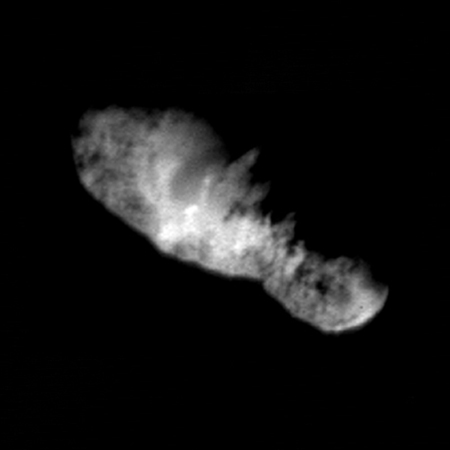Succeed in Space Biz
By Tony Phillips
On December 18, 2001, ground controllers at JPL commanded NASA's Deep Space 1 (DS1) spacecraft to go to sleep. "It was a bittersweet moment," recalls Marc Rayman, the DS1 project manager. Everyone was exhausted, including Deep Space 1, which for three years had taken Rayman and his team on the ride of their lives.
DS1 blasted off atop a Delta rocket in 1998. Most spacecraft are built from tried-and-true technology-otherwise mission controllers won't let them off the ground. But Deep Space 1 was different. Its mission was to test 12 advanced technologies. Among them: an experimental ion engine, a solar array that focused sunlight for extra power, and an autopilot with artificial intelligence. "There was a good chance DS1 wouldn't work at all; there were so many untried systems," recalls Rayman.
Nevertheless, all 12 technologies worked; the mission was a big success.
Indeed, DS1 worked so well that in 1999 NASA approved an extended mission, which Rayman and colleagues had dreamed up long before DS1 left Earth-a visit to a comet. "We were thrilled," says Rayman.
And that's when disaster struck. DS1's orientation system failed. The spacecraft couldn't navigate!
What do you do when a spacecraft breaks and it is 200 million miles away? "Improvise," says Rayman.
Ironically, the device that broke, the 'Star Tracker,' was old technology. The DS1 team decided to use one of the 12 experimental devices-a miniature camera called MICAS-as a substitute. With Comet Borrelly receding fast, they reprogrammed the spacecraft and taught it to use MICAS for navigation, finishing barely in time to catch the comet. "It was a very close shave."
In September 2001, DS1 swooped past the furiously evaporating nucleus of Comet Borrelly. "We thought the spacecraft might be pulverized," Rayman recalls, but once again DS1 defied the odds. It captured the best-ever view of a comet's heart and emerged intact.
By that time, DS1 had been operating three times longer than planned, and it had nearly exhausted its supply of thruster-gas used to keep solar arrays pointed toward the Sun. Controllers had no choice but to deactivate the spacecraft, which remains in orbit between Earth and Mars.
Rayman has moved on to a new project-Dawn, an ion-propelled spacecraft that will visit two enormous asteroids, Ceres and Vesta, in 2010 and 2014. "Dawn is based on technologies that DS1 pioneered," he says.
Even asleep, DS1 continues to amaze.
Find out more about DS1 at http://nmp.jpl.nasa.gov/ds1 . For kids, go to http://spaceplace.nasa.gov/ds1dots.htm to do an interactive dot-to-dot drawing of Deep Space 1.

This was the final image of the nucleus of comet Borrelly, taken
just 160 seconds before Deep Space 1's closest approach to it. This
image shows the 8-km (5-mile) long nucleus from about 3417 kilometers
(over 2,000 miles) away.
This article was provided by the Jet Propulsion Laboratory,
California Institute of Technology, under a contract with the National
Aeronautics and Space Administration.

